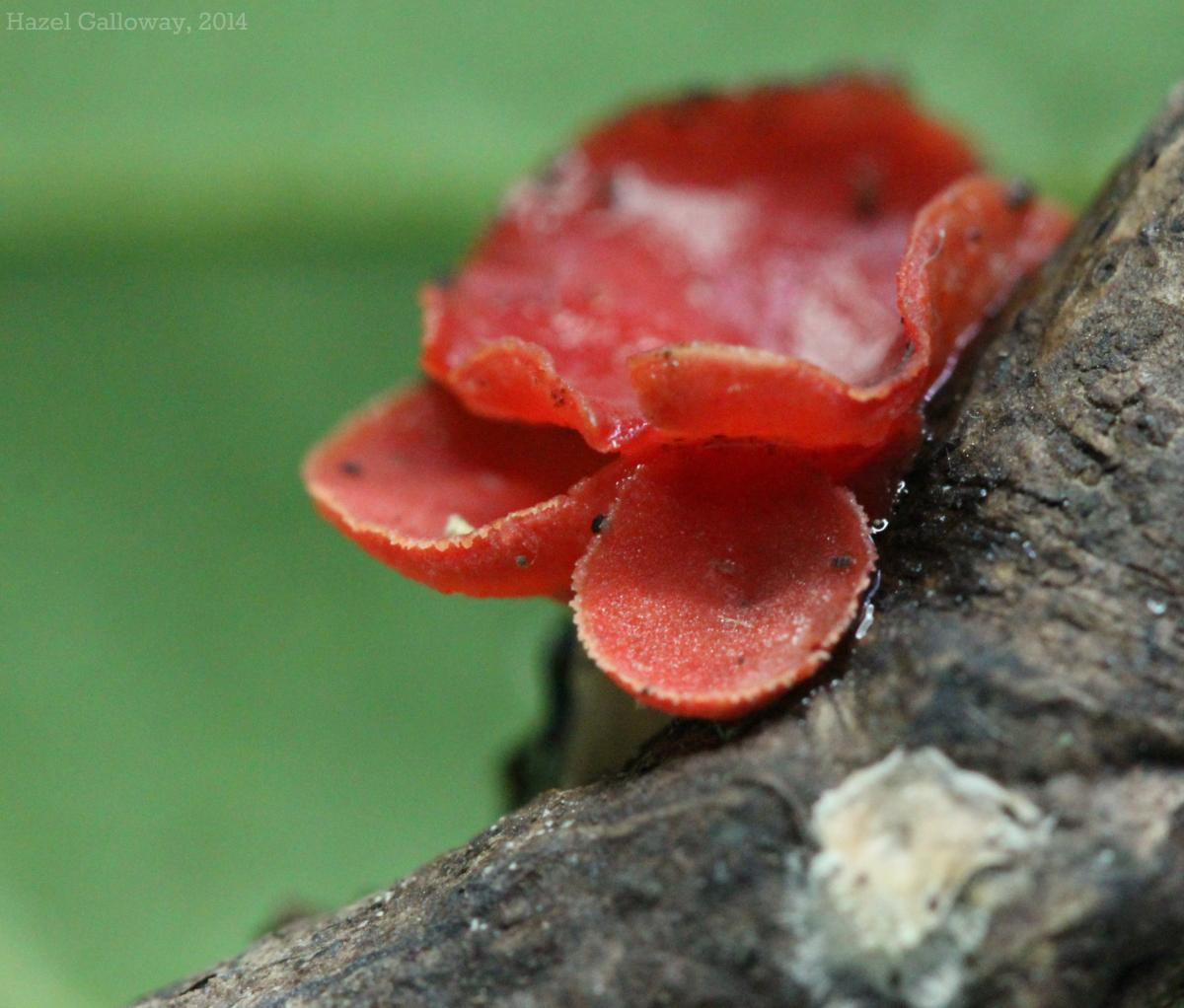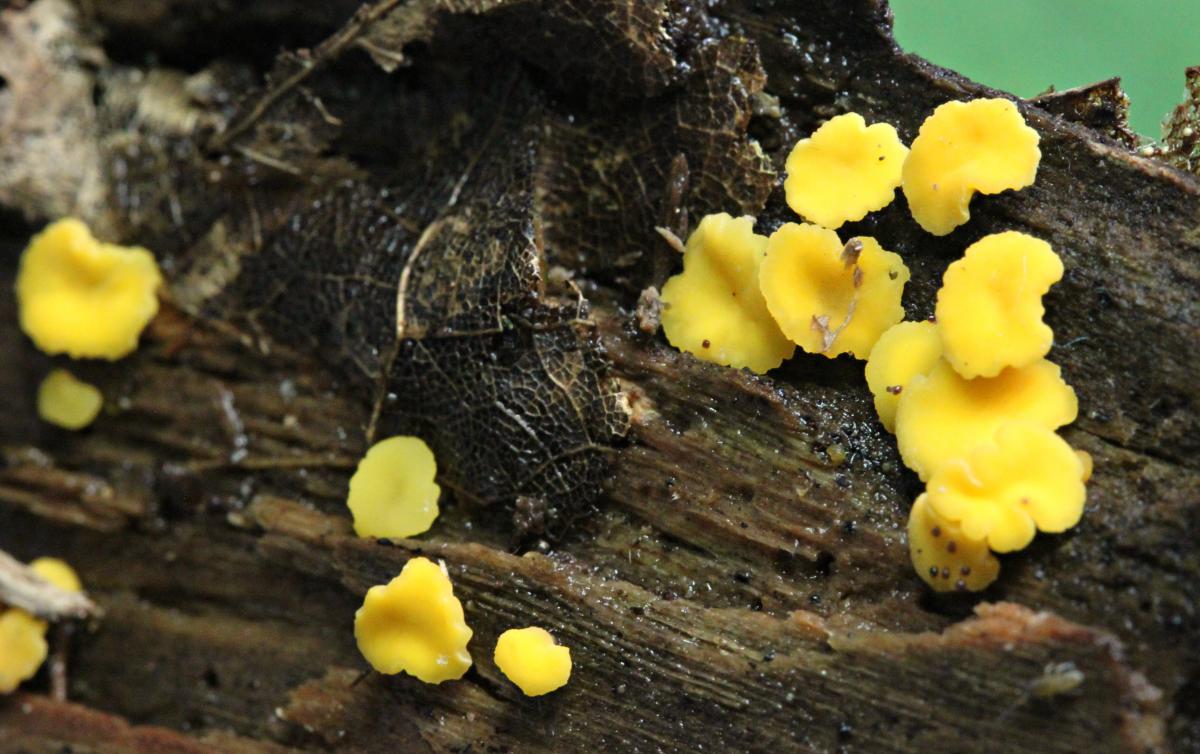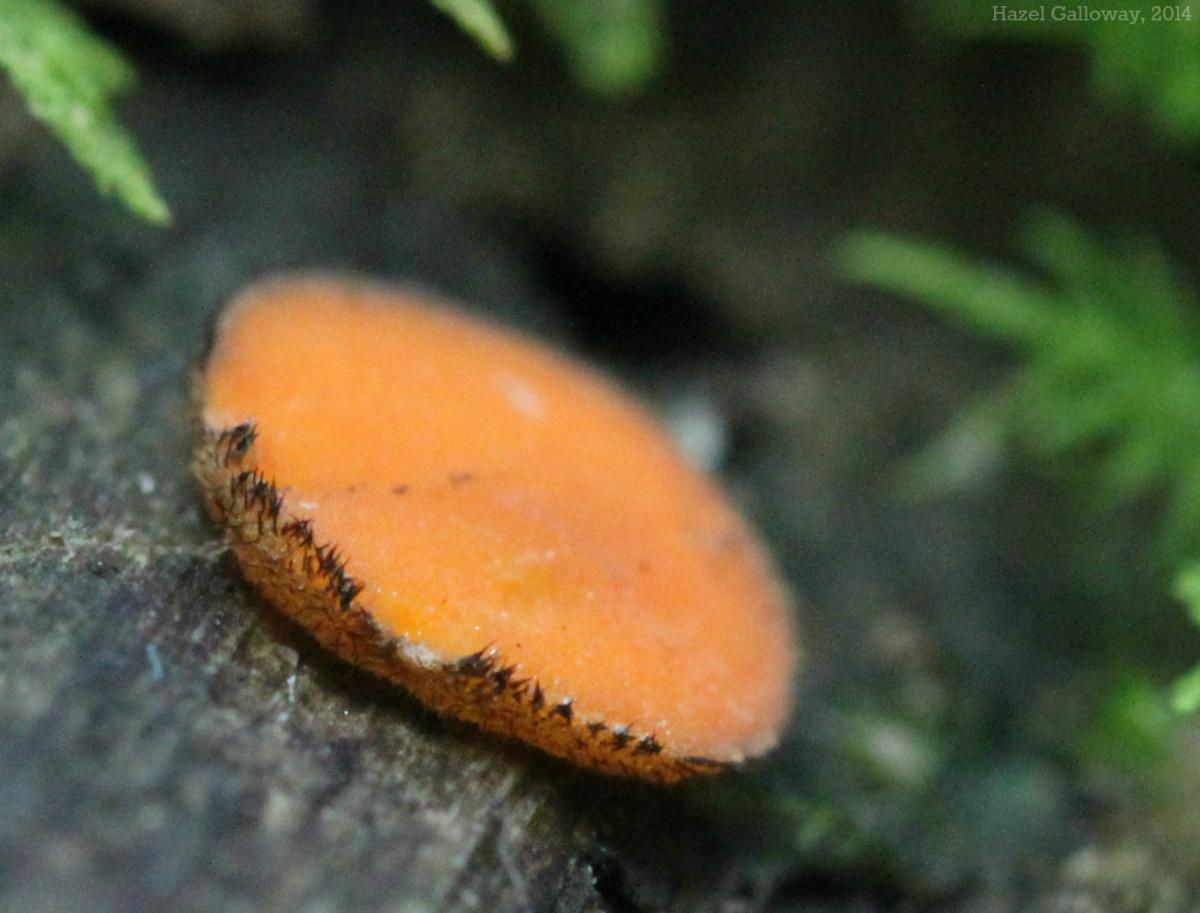These five species of colorful cup fungi, all collected over the course of a morning in the same area, represent between them four entirely different taxonomic families. Indeed, the greatest common denominator between them lies in their shared classification as ascomycetes.
The ascomycetes are the largest subdivision of fungi, comprising over 15,000 known species. Species from yeasts and bread molds to morel and truffles all share the ascomycetes’ distinguishing feature of producing spores inside sac-like cells known as asci. The root “asc” is derived from the Greek “askos,” meaning wineskin, and appears across biology from ascons (sac-like sponges) to the family Ascidiaceae (sac-like tunicates). The remainder of fungi, known as basidiomycetes, produce spores on the exterior, rather than within, specialized cells called basidia. Although this distinction is microscopic, it is often possible to determine to which of the two a fungus belongs by structure alone. As far as macroscopic, fleshy fungi are concerned, the majority are basidiomycetes. These include all gilled and pored mushrooms, bracket fungi, jelly fungi, coral and club fungi, puffballs, earthstars, and stinkhorns. More unusual shapes, such as cup fungi, saddle fungi, earth tongues, truffles, and morels, on the other hand, all belong to the Ascomycota.
Although they are taxonomically distinct, the five species are morphologically and ecologically quite similar. Each cup- or disk-shaped fungus is divided into a spore-producing, or fertile, upper surface and a non-spore producing, sterile lower surface. The fertile surface contains the asci (see right), which produce four or eight haploid spores by meiosis. When mature, the asci become turgid and eventually burst, releasing the spores into the air. If a spore settles in favorable conditions and germinates, it grows into a network of haploid mycelium—underground fungal tissue similar to plant roots. When the hyphae of two different individuals meet, they undergo a process called plasmogamy, where the two cells—but not their nuclei—fuse together. The now-dikaryotic (having two nuclei) cells grow into a dikaryotic mycelium, which can produce a fruiting body. The inside the developing asci in the fruiting body, the two nuclei finally fuse together (karyogamy) to create a diploid cell. However, barely has the ascus become diploid when it must again undergo meiosis to produce haploid nuclei, destined to become spores. This fairly bizarre life cycle is supplemented by asexual reproduction; mycelium that are still haploid often produce haploid fruiting bodies (conidiophores). These generate special spores (conidia) with genotypes identical to that of the parent mycelium. Like other spores, the conidia germinate and produce their own mycelium.
As with most fungi, all of these species are saprobic—that is, they acquire energy from decomposing organic matter. Saprobic fungi are, in fact, the only multicellular organisms capable of digesting cellulose and lignin, two main components of wood. Saprobes are of tremendous importance as decomposers and nutrient recyclers in the environment—when left to their own devices, some species of fungi have been found to reduce the mass of a quantity of leaf litter by 57% in under two years.
Scarlet Cup Fungus
Sarcoscypha spp.
This specimen belongs to one of two species (S. dudleyi or S. austriaca) only distinguishable by the examination of their spores under the microscope. S. dudleyi produces spores with consistently rounded ends and several large oil drops attached; spores of S. austriaca often have flattened ends and many smaller oil droplets. In addition, microscopic hairs growing on the fertile surface of S. austriaca are described as “curling and twisting,” unlike those on S. dudleyi. The two species are otherwise identical, with sometimes-irregular, sup-shaped fruiting bodies that can reach 7 cm in diameter and sport a bright red or scarlet fertile surface and a lighter, hairy sterile surface. Both can be found on decaying hardwood sticks and logs throughout North America east of the Rocky Mountains.
Yellow Fairy Cup
Bisporella citrina
Although minute, B. citrina deserves its citrus-derived epithet. It rarely exceeds 3 mm in diameter, with lemon- to golden-yellow, smooth fertile and sterile surfaces. It is usually found in clusters on decaying wood in the summer and fall across much of North America.
Eyelash Pixie Cup
Scutellinia scutellata
This bright little fungus earns its common name by the tiny, dark, eyelash-like hairs ringing the margin of the inner, fertile surface. They vary in size from minute to 1.5 cm in diameter, and are typically found growing in clusters on wet, rotting wood or damp soil nearby. The lower, sterile surface is a darker color and covered with short, dark hairs. The distinctive bright orange-to-scarlet color and eyelashes are, unfortunately, shared by a number of similar species. Although microscopic examination is often necessary, the substrate the fungi are found on can be a useful identifying factor (many similar species are found on soil, rather than rotting wood). S. scutellata, literally meaning “little dish, little dish,” is widely distributed across North America.
 Brown Cup Fungi
Brown Cup Fungi
Peziza spp.
Brown cup fungi are difficult to identify without microscopic examination. Both these species are saprobic on decaying wood. All of these specimens were found on the Dolinger property near Hunter’s branch.
Hazel Galloway
Sources:
- Arora, David. Mushrooms Demystified. Berkeley: Ten Speed Press, 1986.
- http://www.chpwner.org/wiki-scholars/biology/classification/fungi/ascomycota/Ascomycete%20Lifecycle.jpg
- http://www.britannica.com/EBchecked/topic/38011/ascus
- http://www.mushroomthejournal.com/greatlakesdata/Terms/sapro89.html
- http://www.mushroomexpert.com/scutellinia_scutellata.html
- http://www.messiah.edu/oakes /fungi_on_wood/cup%20and%20saucer/species%20pages/Scutellinia%20scutellata.htm
- http://www.mushroomexpert.com/bisporella_citrina.html
- https://www.messiah.edu/Oakes/ fungi_on_wood/cup%20and%20saucer/species%20pages/Bisporella%20citrina.htm
- http://www.mushroomexpert.com/sarcoscypha_austriaca.html
- http://www.mushroomexpert.com/sarcoscypha_dudleyi.html



